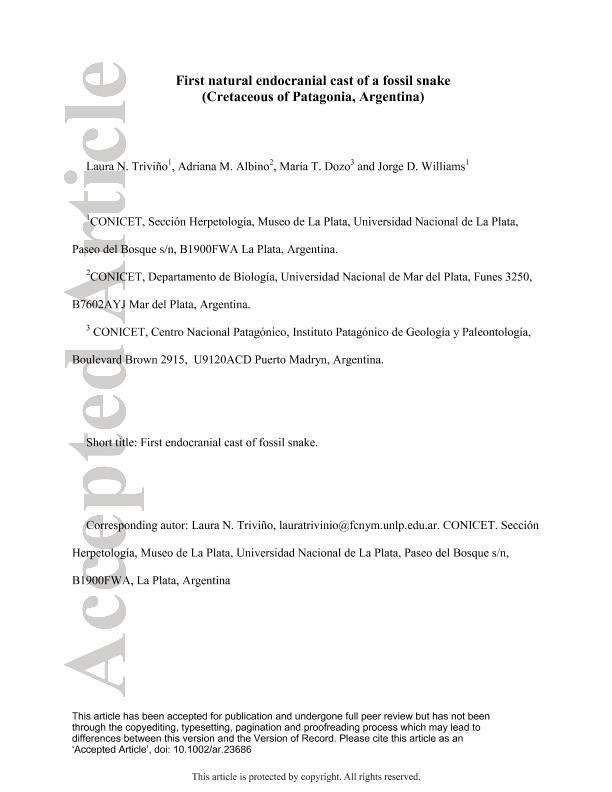Artículo
First Natural Endocranial Cast of a Fossil Snake (Cretaceous of Patagonia, Argentina)
Fecha de publicación:
10/2017
Editorial:
Wiley-liss, Div John Wiley & Sons Inc
Revista:
Anatomical Record-Advances in Integrative Anatomy and Evolutionary Biology
ISSN:
1932-8486
Idioma:
Inglés
Tipo de recurso:
Artículo publicado
Clasificación temática:
Resumen
In this study, we describe a natural endocranial cast included in a partially preserved medium‐sized skull of the Upper Cretaceous South American snake Dinilysia patagonica. The endocast is composed of sedimentary filling of the cranial cavity in which the posterior brain, the vessels, the cranial nerves, and the inner ear surrounded by delicate semicircular canals, are represented. It is simple in form, with little differentiation between the three main areas (Forebrain, Midbrain, and Hindbrain), and without flexures. The nervous system is well preserved. The posterior brain surface is smooth, except for two small prominences that make up the cerebellum. A large inner ear is preserved on the right side; it consists of a voluminous central mass, the vestibule, which occupies most of the space defined by the three semicircular canals. In particular, the lateral semicircular canal is very close to the vestibule. This characteristic, in combination with the medium to large body size of Dinilysia, its large skull and dorsally exposed orbits, and vertebrae bearing a rather high neural spine on a depressed neural arch, suggests that this snake would have had a semifossorial lifestyle.
Palabras clave:
Snakes
,
Cretaceous
,
Dinilysia Patagonica
,
Palaeoneurology
Archivos asociados
Licencia
Identificadores
Colecciones
Articulos(CCT - LA PLATA)
Articulos de CTRO.CIENTIFICO TECNOL.CONICET - LA PLATA
Articulos de CTRO.CIENTIFICO TECNOL.CONICET - LA PLATA
Articulos(IPGP)
Articulos de INSTITUTO PATAGONICO DE GEOLOGIA Y PALEONTOLOGIA
Articulos de INSTITUTO PATAGONICO DE GEOLOGIA Y PALEONTOLOGIA
Citación
Trivino, Laura Natalia; Albino, Adriana Maria; Dozo, Maria Teresa; Williams, Jorge Daniel; First Natural Endocranial Cast of a Fossil Snake (Cretaceous of Patagonia, Argentina); Wiley-liss, Div John Wiley & Sons Inc; Anatomical Record-Advances in Integrative Anatomy and Evolutionary Biology; 301; 1; 10-2017; 9-20
Compartir
Altmétricas




